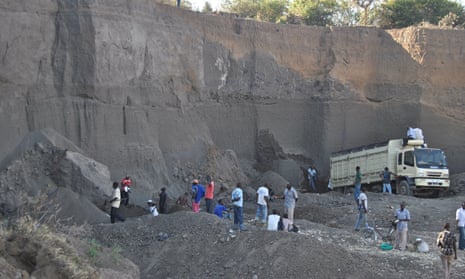Allan Karanja, 22, is a sand harvester. His job is complex and arduous, and involves working in deep pits, equipped only with a shovel and crowbar, and no protective gear, as he mines sand. It is a deadly occupation.
In the Rhonda area, south of Nakuru town and next to Lake Nakuru national park, in Kenya’s Rift Valley region, is an area characterised by sprawling ramshackle settlements. Here, hundreds of young people engage in sand mining, with the Ndarugu river, which flows into the national park, the main site of sand harvesting.
Karanja tells IPS he has seen many of the workers around him die when weakened steep walls collapse in the midst of excavation. “Hunger is what drives us into these sand mines. We earn peanuts here despite the risks we undergo. We excavate sand without safety helmets,” he says.
In 2010, Nakuru town, 160km north-west of Kenya’s capital Nairobi, was voted by the UN human settlements programme, UN-Habitat, as the fastest-growing town in east and central Africa. The title resulted in a rush of investors to the area and a boom in the construction industry – the main consumers of sand. Rhonda is the leading source of sand in the Rift Valley region. Sand mining dates back to the early 1980s.
Jackson Kemboi owns a two-hectare (five-acre) sand quarry where two workers died when a wall collapsed last month. It prompted Kemboi to close the quarry temporarily. He says sand mining in Rhonda provides employment to about 3,000 people. “This quarry has been in existence since the early 1980s. We do not have the capacity to employ those excavating sand on a monthly salary basis since, as the owner, I have to share the amount earned per seven-tonne lorry with all involved. These young men come on a daily basis, engage in scooping and loading sand, and get their wage at the end of the day,” Kemboi says. He charges $58 per truck of sand, with 20% of that shared among miners, loaders and truck drivers as wages.
Jack Omare, a father of two, says he has been working at Kemboi’s sand mine since 1992. He says he has escaped death three times. The worst incident, he says, was when weak sand walls collapsed, pushing him and a truck driver into the Ndarugu river. They both survived. That month, three people died when a wall collapsed in Kirinyaga, Meru County. Omare says he earns a minimum of $3. It is a meagre amount, just enough to provide a meal for him, his wife and his children.
Sand, a burgeoning industry
Sand is becoming a necessary component in fuelling the construction boom that is driving the rapid urbanisation and economic growth in the country.
The Kenya Economic Report 2013 (pdf), by the Kenya Institute for Public Policy Research and Analysis, predicted that the economy would grow by about 5.5% in 2013 and 6.3% in 2014, compared with 4.6% in 2012.
Anne Waiguru, a cabinet secretary in the ministry of devolution and planning, says the urban population is growing at 4% per annum. She says it can be attributed to Kenya’s 2008 post-election violence as well as young people migrating from rural to urban areas in search of jobs.
But many of Kenya’s poor youngsters are turning to sand mining as a quick way to earn money, despite the deadly risks. And Karanja is among many young people facing exploitation in the industry.
According to Mary Muthoni, an official with local government child welfare, about 3,000 young people, most of whom are underage, are involved in some of the worst forms of labour here, including sand mining.
An official with Kenya’s Child Welfare Society, a government agency, says youngsters engaged in mining are exposed to toxic materials, which increase their chances of developing respiratory diseases. “At 14, I would opt to miss classes at Kaptembwa primary school to go off loading sand into trucks to enable me purchase basic school items,” he says. He quit before going to high school.
Environmental degradation
Last year, the National Environmental Management Authority ordered the closure of all sand mines in Nakuru as it emerged that mining was contributing to environmental degradation. According to Nema, sand mining in Nakuru has contributed to the Ndarugu river’s siltation and poses a threat to nearby public utilities and infrastructure such as roads and schools.
“The ban remains active,” Wilfred Osumo, Nakuru’s Nema director, says. “As an authority, we have no problem with effecting the law but we are considering the lives of thousands of the youth, who would remain jobless.” He says those who want to continue with the business, especially quarry owners, are required to apply for an environmental impact assessment licence, issued by Nema at a cost of 0.1% of the project’s cost.
Nema’s 2007 national sand harvesting guideline stipulates that sand harvesting or scooping is restricted to riverbeds, with no harvesting allowed on riverbanks, to avoid widening of rivers.
“Sand harvesting in Rift Valley is done along the riverbeds, which is of poor quality as compared to earth sand mining in parts of eastern Kenya, namely Machakos, Kitui and Makueni,” Professor Jackson Kitetu, an environmental scientist specialising in sand harvesting research in Kabarak University, says.
His research study between 1993 and 1997 revealed that sand harvesting in eastern Kenya provided 30,000 jobs. And, despite the risks, people will continue working in the industry.
Mike Mwangi, a licensed driver on the sand mines, says it is his preferred source of income despite the challenges. “I tried hawking fruit in Nakuru town but was frustrated by municipality officials. I had to quit and get back to this deadly job, sand harvesting.”
